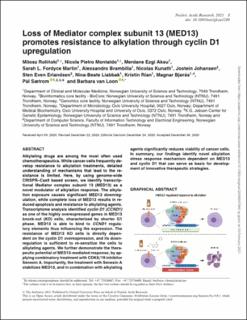| dc.contributor.author | Rolinski, Milosz | |
| dc.contributor.author | Montaldo, Nicola Pietro | |
| dc.contributor.author | Aksu, Merdane Ezgi | |
| dc.contributor.author | Martin, Sarah Fordyce | |
| dc.contributor.author | Brambilla, Alessandro | |
| dc.contributor.author | Kunath, Nicolas | |
| dc.contributor.author | Johansen, Jostein | |
| dc.contributor.author | Erlandsen, Sten Even | |
| dc.contributor.author | Liabakk, Nina-Beate | |
| dc.contributor.author | Rian, Kristin | |
| dc.contributor.author | Bjørås, Magnar | |
| dc.contributor.author | Sætrom, Pål | |
| dc.contributor.author | van Loon, Barbara | |
| dc.date.accessioned | 2021-02-19T12:56:12Z | |
| dc.date.available | 2021-02-19T12:56:12Z | |
| dc.date.created | 2021-01-04T11:47:22Z | |
| dc.date.issued | 2020 | |
| dc.identifier.citation | Nucleic Acids Research. 2020, . | en_US |
| dc.identifier.issn | 0305-1048 | |
| dc.identifier.uri | https://hdl.handle.net/11250/2729269 | |
| dc.description.abstract | Alkylating drugs are among the most often used chemotherapeutics. While cancer cells frequently develop resistance to alkylation treatments, detailed understanding of mechanisms that lead to the resistance is limited. Here, by using genome-wide CRISPR–Cas9 based screen, we identify transcriptional Mediator complex subunit 13 (MED13) as a novel modulator of alkylation response. The alkylation exposure causes significant MED13 downregulation, while complete loss of MED13 results in reduced apoptosis and resistance to alkylating agents. Transcriptome analysis identified cyclin D1 (CCND1) as one of the highly overexpressed genes in MED13 knock-out (KO) cells, characterized by shorter G1 phase. MED13 is able to bind to CCND1 regulatory elements thus influencing the expression. The resistance of MED13 KO cells is directly dependent on the cyclin D1 overexpression, and its downregulation is sufficient to re-sensitize the cells to alkylating agents. We further demonstrate the therapeutic potential of MED13-mediated response, by applying combinatory treatment with CDK8/19 inhibitor Senexin A. Importantly, the treatment with Senexin A stabilizes MED13, and in combination with alkylating agents significantly reduces viability of cancer cells. In summary, our findings identify novel alkylation stress response mechanism dependent on MED13 and cyclin D1 that can serve as basis for development of innovative therapeutic strategies. | en_US |
| dc.language.iso | eng | en_US |
| dc.publisher | Oxford University Press | en_US |
| dc.rights | Navngivelse 4.0 Internasjonal | * |
| dc.rights.uri | http://creativecommons.org/licenses/by/4.0/deed.no | * |
| dc.title | Loss of Mediator complex subunit 13 (MED13) promotes resistance to alkylation through cyclin D1 upregulation | en_US |
| dc.type | Peer reviewed | en_US |
| dc.type | Journal article | en_US |
| dc.description.version | publishedVersion | en_US |
| dc.source.pagenumber | 15 | en_US |
| dc.source.journal | Nucleic Acids Research | en_US |
| dc.identifier.doi | 10.1093/nar/gkaa1289 | |
| dc.identifier.cristin | 1864699 | |
| dc.relation.project | Kreftforeningen: 190394 | en_US |
| dc.description.localcode | C The Author(s) 2021. Published by Oxford University Press on behalf of Nucleic Acids Research. This is an Open Access article distributed under the terms of the Creative Commons Attribution License (http://creativecommons.org/licenses/by/4.0/), which permits unrestricted reuse, distribution, and reproduction in any medium, provided the original work is properly cited. | en_US |
| cristin.ispublished | true | |
| cristin.fulltext | original | |
| cristin.qualitycode | 2 | |

